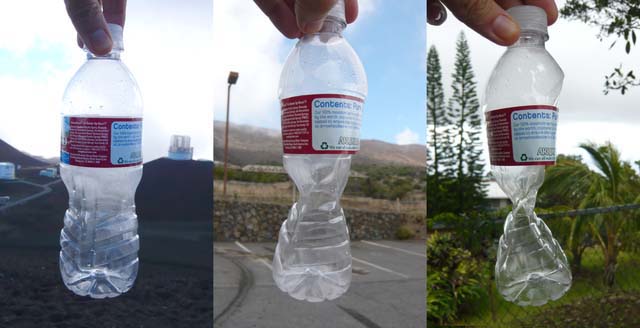What is Air Pressure?
Introduction
What is air pressure? Air pressure is the weight of air molecules pressing down on the Earth. The pressure of the air molecules changes as you move upward from sea level into the atmosphere. The highest pressure is at sea level where the density of the air molecules is the greatest.

Measuring air pressure on island of Hawaii. Left picture taken at 14,000 ft at Mauna Kea observatory when the bottle was sealed. Middle picture of the sealed bottle at 9000 ft. Last picture taken at 1000 feet where the bottle was crushed.
Barometers measure air pressure
Meteorologists use barometers to measure the pressure of the air when making weather forecasts and studying weather patterns. Barometric pressure given in weather reports is giving the barometric reading in either inches of centimeters. Pressure on the barometer moves the column of mercury in a cylinder upward or downward. Readings of barometric pressure are taken by looking at the markings on the outside of the glass cylinder. Barometers are calibrated with inches or centimeters.
Mercury used for measuring pressure
The United States National Weather Service uses inches of mercury when they issue weather reports about the Earth’s surface. Measurements aloft are given in millibars. Millibars and barometers using inches and centimeters are slowly being phased out.
Hectopascal measurements
Today hectopascal measurements are worldwide by meteorologists because they are a direct measurement of pressure. A hectopascal measurement is similar to a measurement in pounds per square inch. Measurements in hectopascal are preferred because they can be used by meteorologists to study weather patterns. They can also be used with computer programs to predict the weather.


Click for More Information and to Order
What is Air Pressure
Sea level air pressure
The greatest air pressure pressing down on our bodies is at sea level. Scientists use the term one atmosphere to describe the pressure at sea level. Normal pressure at sea level is 14.7 psi (pounds per square inch). Normal pressure at sea level measures 29.9213 inches (760 mm) on barometers. This means that on every square inch of our body and
At sea level on the surface of the Earth there is almost a ton of pressure pressing on every square inch of our body. The reason we are able to move our hands back and forth is because the pressure is equal on all parts of our hands. Our bodies are not crushed by the weight of the pressure because there is equal pressure inside and out of our bodies also.
Decreasing air pressure
Air pressure decreases as we move upward. Your ears will often pop if you are traveling in the mountains as you go uphill and downhill in a car or train. Your ears are adjusting to the pressure in your eardrums when they pop. This equalizes the pressure in your ears so they will not burst when the pressure increases or decreases.
More Weather Links
Weather Facts: The weather affects our everyday lives throughout the year. Use the links on this page to learn about hurricanes, the Earths atmosphere layers, air pressure, lightning and thunderstorms.
Formation of hurricanes in North Pacific Ocean occurs in two basins. They are the two most active basins for cyclones to form on our planet. Meteorologist recognized the north eastern Pacific Ocean basin 1920s.
The Earths atmosphere layers are similar to the interior of the Earth. Find out about the four major layers of atmosphere that are separated by temperature.
What is air pressure? It is the weight of air molecules pressing down on the Earth. The pressure changes as you move upward into the atmosphere.
What causes lightning and what are the warning signs before lightning strikes? Find out on this fascinating page about lightning.
What are thunderstorm clouds and how do they form? Find out how severe thunderstorms produce rain, lightning, hail and occasionally tornadoes.
KIDS FUN Science Bookstore
Check out Myrna Martin's award winning textbooks, e-books, videos and rock sets. The Kids Fun Science Bookstore covers a wide range of earth science topics. Click here to browse.










